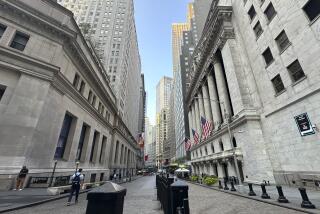Service Sector Surges in June
- Share via
Two economic reports Thursday gave hopeful signs that the nation’s economy is improving, despite some downbeat data on June employment trends.
Service-sector activity grew at its best rate in more than 2 1/2 years in June, bolstered by rising new orders and an increase in optimism.
Separately, the nation’s leading economists are increasing their U.S. growth forecasts for the rest of this year and early 2004.
The Institute for Supply Management said its non-manufacturing index rose to 60.6 in June from 54.5 in May and 50.7 in April. The gauge is made up mostly of services, which constitute more than two-thirds of U.S. economic output. The June reading is the best since the 60.7 in September 2000.
Index readings above 50 indicate expansion of activity and prices in the non-manufacturing sector; readings under 50 denote contraction. June’s reading exceeded the 55 mark economists had expected.
Ralph Kauffman, chairman of the ISM committee that conducts the survey, said the report was encouraging. “What really took me by surprise was that not one of the 17 sectors we sample reported slower activity in June. It was really broad-based,” he said, referring to the improvement over May.
The components that constitute the ISM report were generally positive. The new orders index, which can be an indicator for future activity, moved up to 57.5 in June from 54.7 in May and 50.6 in April. The ISM employment gauge rose to 50.3 in June from 48.7 in May.
The report took some of the sting out of the government’s report that the economy shed a net 30,000 jobs last month.
In its monthly survey of 60 of the nation’s top economists, Bloomberg News found that, as a group, they believed the economy would improve into 2004.
Gross domestic product will expand at a 3.5% annual rate in the current quarter and accelerate to 3.7% in the fourth quarter, based on the median forecasts of the economists. Those are up from predictions of 3.2% and 3.5% in last month’s survey.
Economists raised estimates after the Federal Reserve cut its benchmark interest rate to a 45-year low of 1% on June 25. The latest survey was done in the days after the Fed meeting.
The economy expanded at a 1.4% annual rate in the first quarter and didn’t gain much traction during the Iraq war from March into May.
But some recent data have shown improvement. What’s more, the stock market now has risen for four months, and $330 billion in tax cuts are about to take hold.
“With weaker growth in the first half of the year, a little more pent-up demand was generated,” said Anthony Chan, economist at Banc One Investment Advisors in Columbus, Ohio. “That means a little more demand in the second half.”
The Bloomberg survey of forecasts for three economic indicators and three financial rates extends out into the second quarter of 2004. The median growth forecast for next year’s first quarter rose to 3.8% from 3.6%.
The consumer price index, the government’s broadest measure of inflation, will slow to 1.8% in the first three months of next year, according to the median forecast in the survey, less than the 2.6% average over the last decade.
In other economic news Thursday, rates on 30-year and 15-year mortgages jumped to a seven-week high this week, tracking a surge in Treasury bond yields in recent weeks.
But even with the increase, mortgage rates probably will remain at sufficiently low levels to support the housing market, many analysts say.
The average rate on a 30-year fixed-rate mortgage this week was 5.4%, a sizable increase from last week’s rate of 5.24%, mortgage giant Freddie Mac said in its weekly nationwide survey.
Three weeks ago, rates on 30-year mortgages slid to 5.21%, the lowest level since Freddie Mac began tracking this benchmark mortgage in 1971.
For 15-year fixed-rate mortgages, a popular option for refinancing, rates rose to 4.75% from 4.63% last week.
More to Read
Inside the business of entertainment
The Wide Shot brings you news, analysis and insights on everything from streaming wars to production — and what it all means for the future.
You may occasionally receive promotional content from the Los Angeles Times.










